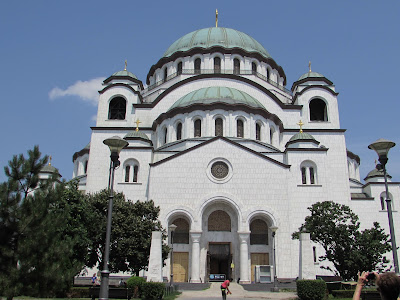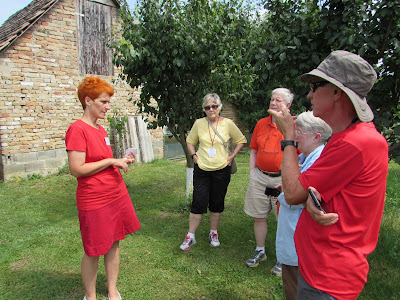Belgrade and the rest of Serbia are just now emerging from many years of repressive rule.
We toured around this old city, which was built centuries ago along important east-west trade routes. It was used as a gateway to Western Europe from the Balkans.
Our first stop was at the Kalemegdan Fortress where we could overlook the confluence of the Danube and Sava Rivers.
The statue of the Victor is one of the most famous landmarks in Belgrade, located in the Belgrade fortress at the place where the medieval castle once stood. It was erected in 1928 to commemorate the Kingdom of Serbia's war victories over the Ottoman Empire (First Balkan War) and Austria-Hungary (World War I).
The statue was originally supposed to be placed on the Terazije square in the city center, but ended up at the Belgrade Fortress after people complained about its nudity.
The statue holds a falcon, on watch for the new threats on the horizon, in one hand, and a sword of war, ready to counter these threats in the other. It is looking forward across the confluence of the Sava and the Danube rivers, and towards (at the time) the Austro-Hungarian empire. It is probably the most powerful, most popular visual symbol of Belgrade.
The Tito Memorial was erected to honor Josip broz Tito, who held Yugoslavia together as an independent country in the turmoil that followed World War II and the subsequent Cold War.
After his death on May 4, 1980, Josip Broz Tito was buried in the House of Flowers, set in the museum grounds. The museum has a collection of more than 200,000 items that illustrate the history of Yugoslavia throughout the 20th century, with special emphasis on the life and work of Tito.
With our local guide, Tanya translating, we listened to an elderly local man tell us how he preferred life under Tito's rule (communism) better than what he has today. The younger generation does not agree.
The last stop on our tour was at the Sava Orthodox Cathedral--the largest Orthodox cathedral in the world.
Construction started 100 years ago and it will take about another 15-25 years to finish the interior.
The mosaics inside still need to be completed.
The church is a replica of Istanbul's Hagia Sophia, which was first a Christian church.
That evening a wonderful Serbian dance troop entertained us on the ship.
On Day 9 of the cruise we stopped in Novi Sad, Serbia's cultural hub and second-largest city. We took a walk into the city with a local guide. He told us of all the wars and how bridges were destroyed in the 1999 war with Croatia.
Photographs of some of the bridges before and after the bombings.
The monument is to the victims of January, 1942, when gypsies and Jews were killed and thrown into the river.
The name Novi Sad translates to "new garden"; we walked through parks filled with beautiful gardens on our way to the city square.
.We soon reached the city square.
The Town House
The Name of Mary Church (Crkva imena Marijinog) is located across from the Town House in the center of Novi Sad.
The church was built by architect Georg Molnar in 1895 on the foundation of an older Roman Catholic church. It was built in the Gothic Revival style and it is dedicated to the Virgin Mary.
Because of its roof and spires, visitors sometimes call it the "colorful church".
Walking back through the parks with our friends, we headed to the ship for lunch.
In the afternoon we took a tour in the town of Sremski Karlovci located just a few miles from Novi Sad on the Danube River. Our guide was Ljuba, sister to one of our Program Directors.
The Patriarch Palace, built in 1892, was the first residence of the head of the serbian church. Today it is the residence of the bishop and a Museum of the Serbian Orthodox Church.
Walked by the Catholic and Orthodox churches, standing side by side.
At the Four Lions Fountain, one of these ladies lifted her blouse and flashed Jack and said drink the water. Seems the fountain's superstition is that if you drink from the fountain you will return to marry here, and she had her eyes on Jack.
The school is the oldest Serbian high school, named for Branko Radicevic, a student who later became one of the most famous Serbian writers.
In the courtyard is a statue dedicated to Radicevic. The school specializes in languages and is free to very good students.
As we headed back to the bus, we passed the Orthodox church and saw a bride and groom entering.
Our guide said it was fine for us to follow the crowd in for a peek inside the church.
We stayed for only a moment to catch a glimpse of the ornate interior of the church.
Our last stop on the tour was to a bee keeping museum and a 300-year old wine cellar. We sampled wine and honey.
Then we learned about the wine....
and got to sample both the wines and the honey.
That evening we had dinner at Farm 137 outside of Novi Sad.
There was musical entertainment....
...and a gypsy woman who found our friend Jack entertaining.
The next day we arrive in Vukovar, Croatia, where we leave the ship for a tour and watch our ship depart. It will meet us upstream after lunch.
We walk toward the town and past a hotel that was damaged in the Croatian-Serbian war and a cross memorial for war victims.
Vukovar is the site of the worst artillery shelling of that war. Before leaving Vukovar by bus, we stop by the landmark of the war years...the water tower that was heavily damaged.
We then headed out on our bus....passing by another stork's nest.
We arrived at the town of Osijek, the administrative and economic center of eastern Croatia. This area was first settled by the Romans, but its advantageous geographical location made it prey to assault throughout the centuries.
We walked by Tvrdja, a military fortress that was built between 1712 and 1721.
The Holy Trinity Column was erected in the fort's main square in 1730 as a monument to the plague.
The Church of the Holy Cross has a statue of Mary and baby Jesus inside that is 500 years old.
We then were driven to a village where we were in a group of 8 for a Home-Hosted Lunch. Our host was Ramona and we chatted with her about her life, family, and shared our stories, too.
Lunch was a vegetable soup, meat patties, and a bean/noodle dish along with bread and white wine. Dessert was cherry cake. All was grown either by Ramona's family or nearby and was very good.
The first part of our river cruise is coming to an end. Tomorrow we arrive in Budapest, Hungary.
To continue reading about our trip, scroll back up toward the top of this page. Click on the link in the right column entitled, "Budapest, the last stop on the first voyage of the cruise".



















































































No comments:
Post a Comment